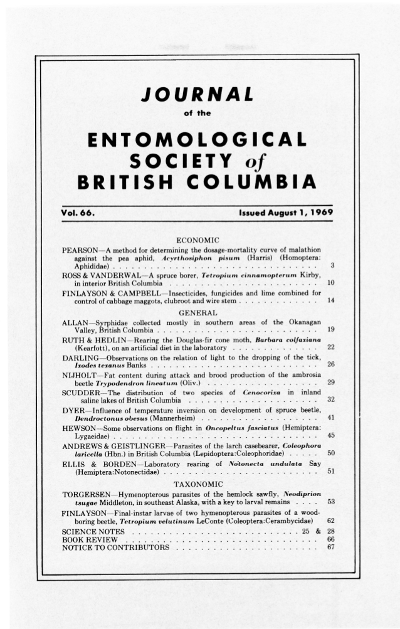Fat content during attack and brood production of the ambrosia beetle <i>Trypodendron lineatum</i> (Oliv.)
Keywords:
ambrosia beetle, <i>Trypodendron lineatum</i>Abstract
After emergence from hibernation the ambrosia beetle, <i>Trypodendron lineatum</i> (Oliv.), flies to attractive host material where it arrives with about one-half the fat it had at the start of hibernation. Analyses of beetles during attack and brood production showed a steady increase in the fat content of males, starting 5 days after the attack. The fat content of the females declined in the first 5 days, then maintained this level for about 1 week after which it rapidly increased.References
Chapman, J.A. 1966. The effect of attack by the ambrosia beetle, Trypodendron lineatum (Olivier) on log attractiveness. Can. Entomol. 98:50-59.
Nijholt, W.W. 1965. Moisture and fat content in the ambrosia beetle Trypodendron lineatum(Oliv.). Proc. Entomol. Soc. Brit. Columbia 62:16-18.
Nijholt, W.W. 1967. Moisture and fat content during the adult life of the ambrosia beetle Trypodendron lineatum (Oliv.). J. Entomol. Soc. Brit. Columbia 64:51-55.
Nijholt, W.W. and J.A. Chapman. 1968. A flight trap for collecting living insects. Can. Entomol. 100:1151-1153.
Prebble, M.L. and K. Graham. 1957. Studies of attack by ambrosia beetles in softwood logs on Vancouver Island, British Columbia. Forest Science 3:90-112.
Downloads
Published
Issue
Section
License
Authors who publish with the Journal of the Entomological Society of British Columbia agree to the following terms:
-Authors retain copyright and grant the journal right of first publication with the work simultaneously licensed under a Creative Commons Attribution License that allows others to share the work with an acknowledgement of the work's authorship and initial publication in this journal.
-Authors are able to enter into separate, additional contractual arrangements for the non-exclusive distribution of the journal's published version of the work (e.g., post it to an institutional repository or publish it in a book), with an acknowledgement of its initial publication in this journal.
-Authors are permitted and encouraged to post their work online (e.g., in institutional repositories or on their website) prior to and during the submission process, as it can lead to productive exchanges, as well as earlier and greater citation of published work (See The Effect of Open Access).


